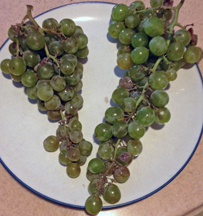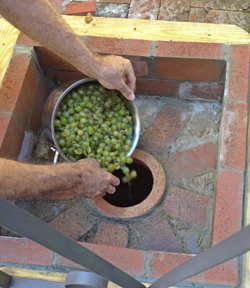 Sometimes plans do not work out. I had planned to purchase Viognier and make a Viognier wine in my qvevri. However, travel from mid-August through mid-October ruled that out. We were not home for stretched long enough to acquire grapes and ferment them in the qvevri. It is always a good idea to have a backup plan.
Sometimes plans do not work out. I had planned to purchase Viognier and make a Viognier wine in my qvevri. However, travel from mid-August through mid-October ruled that out. We were not home for stretched long enough to acquire grapes and ferment them in the qvevri. It is always a good idea to have a backup plan.
We visited S&S Wine Grapes in Jessup, Maryland and purchased two 36 pound lugs of Muscat grapes from Lodi, Californis. This is late in the season for the grapes that had been kept in a refrigerated room for a month or so. We decided to destem them by hand casting the berries into one of three groups. The berries that would go into the qvevri would be placed in one group. They were very sweet and flavorful.
A second group contained berries that had turned color. We did not want them in the qvevri, we did press them and collected their juice. When tasted, the juice was still good. Our third group consisted of raisins. Those went onto a plate and set next to a southern facing window to get some sun exposure. The raisins also tasted good. They will be used in baking for the holidays.
 The grapes collected from the berries to go into the qvevri measured at 25 degrees Brix. After filling the qvevri about ? full, I measured the specific gravity at 1.110. This was going to be a high alcohol wine somewhere near the 15% alcohol range. Then I made my first mistake. I pitched a yeast that I later discovered can only tolerate up to 13% alcohol. Since I did not want my wine to have any sweetness, I pitched another yeast that could tolerate high alcohol. Georgian qvevri winemakers use indigenous yeasts for fermentation. With 8,000 years of grape growing in Georgia, the yeasts have figured it out. I was not going to attempt to use the native yeasts on these grapes.
The grapes collected from the berries to go into the qvevri measured at 25 degrees Brix. After filling the qvevri about ? full, I measured the specific gravity at 1.110. This was going to be a high alcohol wine somewhere near the 15% alcohol range. Then I made my first mistake. I pitched a yeast that I later discovered can only tolerate up to 13% alcohol. Since I did not want my wine to have any sweetness, I pitched another yeast that could tolerate high alcohol. Georgian qvevri winemakers use indigenous yeasts for fermentation. With 8,000 years of grape growing in Georgia, the yeasts have figured it out. I was not going to attempt to use the native yeasts on these grapes.
I covered the qvevri with a plexiglass lid that I drilled a hole for an air lock. There is sign of fermentation. Although the fermentation is somewhat slow. In part, it is cold outside and the forecast is for colder days and night time lows near freezing. The qvevri is underground so it should maintain a temperature high enough for fermentation to continue. After one day I did punch down twice; however, there was not a strong cap. I’ll continue to punch down and monitor the must in the qvevri and see how it is doing.
One last task was to run a coil of clay around the airlock where it fitted into the cover. We also ran a ring of clay around the outer edge of the qvevri so the lid would be pushed into the clay and form a seal. I’m interested to see how well this seal works.
Cheers,
Terry



Leave a Reply